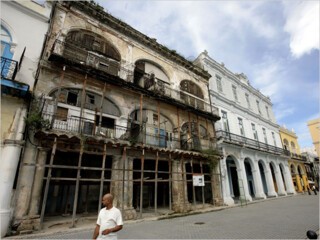Old Havana
John Perry
Visitors to Havana see thousands of old colonial houses, many abandoned when the rich fled to Miami after the revolution, now occupied by ordinary habaneros and most in disrepair. A slow transformation has begun: the core of the city now looks splendid and restoration of the long, wave-battered Malecón is underway. But there is still a long way to go. On the World Affairs blog last week, Michael Totten poured scorn on the efforts to rehabilitate the biggest surviving old colonial city in the Americas, saying it’s still worse than wartime Beirut or Baghdad. He prescribes free enterprise as the remedy: the economy would then ‘go into supernova’.
Totten says that Havana is being fixed up for the tourists yet before 1959 it was truly prosperous. He doesn’t say that the rest of Cuba was kept poor and underdeveloped to serve the needs of the capital and its rich inhabitants. After the Spanish were kicked out, in the first half of the 20th century Cuba was effectively a US colony, playground of the rich and criminal. If you had money and few principles, it was a great place to hang out. If you fell foul of Batista, you ended up in prison or worse. If you were among the one-third living in the slums or a peasant with no land, you had no health service and no schools. By the 1950s Havana’s hedonism was unsustainable, whatever you think of Cuba’s subsequent trajectory.
How does Havana compare with other surviving colonial cities in the Americas, whose historic cores appear in better shape? Cartagena in Colombia has perhaps the most beautiful colonial centre of all. It attracts thousands of tourists, apartments sell for a million dollars and the poor live in slums outside the old city walls. In Mexico City the contrast is much greater but the poor are more hidden: four million of them live in one of the world’s largest slum districts, ten kilometres from the centre.
And in the US, the historic downtown of Baltimore, whose population is almost entirely poor and black, looks far worse than Havana. The preserved colonial quarter of New Orleans looks nice, but nearly 2000 mainly poor inhabitants were killed by Hurricane Katrina. Cuba is sometimes hit by two or three hurricanes a year, but only a handful of people are killed and help with reconstruction arrives far more quickly than it did in Louisiana.
Havana has a severe housing problem but there are few children begging in the streets, all go to school and everyone gets free healthcare. Totten mentions this only in a disparaging quote from a Cuban exile in Miami.
But the most depressing thing about articles like Totten’s is the lack of any critical perspective on what would happen if the Cuban economy really did ‘go into supernova’. Within a generation, Havana would probably be another Miami. Would that be progress? The essential question is how can Cuba adapt and survive when the Castro era ends, leaving behind the worst but retaining the best of what it’s achieved over the last fifty years?


Comments
Parts of Baltimore are scary and not particularly safe. But don't they outwardly look better than Havana?
Suspect most Cubans would celebrate f Cuba became a modified version of Miami. What percent of Cubans do you think would object?
I would also disagree with your assertion that pre Castro Cuba was a US colony. Are Canada and Mexico US colonies because their economies are so interdependent with the US economy?
For an excellent impression of Havana in the Batista years, do please look at 'The Havana Mob: Gangsters, Gamblers, Showgirls and Revolutionaries in 1950s Cuba'. I think in the US it may be called 'Havana Nocturn'. As the review article in LRB mentions, most of the new development taking place in the years up to the revolution was funded by The Mob, and indeed they initially thought Castro was potentially as corruptible as Batista and tried to tempt him. They all left soon afterwards.
But economics aren't the whole story. No part of Canada's constitution was imposed on it by the US, as was true of Cuba:
http://www.lrb.co.uk/v31/n06/piero-gleijeses/cuba-or-the-base